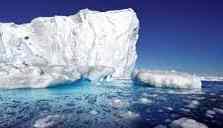Science –Technology
Doomsday glacier is on edge as warm ocean water seeps in quickly
Published
1 year agoon

Doomsday glaciers might contribute to a sea level rise of more than half a metre and further destabilise the glaciers nearby
The Thwaites Glacier, often known as the Doomsday Glacier, is in peril in Antarctica because warm ocean water has infiltrated into its weak points. The glacier is experiencing one of the worst circumstances owing to melting brought on by rising temperatures, which might force it to break off or melt and cause a large rise in sea levels.
Under the floating ice shelf, scientists have made ground-breaking measurements that indicate many crevasses and faults where melting happens more quickly. The crew made the first up-close images of the key spot by deploying a remotely controlled Icefin underwater robot through a roughly 2,000-foot-deep burrow dug in the ice.
Thwaites glaciers have the ability to contribute to a rise in sea level of more than half a metre and to further destabilise the nearby glaciers, which have the capacity to add another three metres. One of the glaciers on the continent that changes the most quickly and is most unstable is the area in Antarctica.
“These new techniques for watching the glacier help us realise that, in these extremely warm regions of Antarctica, what counts is not only how much melting is taking place, but how and where it is occurring. Over warming glaciers like Thwaites, we can detect crevasses and possibly terraces. The glacier is being worn away at its weakest spots as a result of warm water seeping into the fractures, according to Britney Schmidt, an associate professor of astronomy and earth and atmospheric sciences at Cornell University.
The second paper observed about five metres per year of melt near the glacier’s grounding line, which is less than what the most aggressive thinning models predicted in the first paper that was published in the journal Nature. The first paper found that warmer water was leaking into crevasses and other openings known as terraces.
Read Also: Meteorite that fell in Gujarat in August was a rare aubrite that had not been seen in 170 years
“Icefin is gathering information in places where no other tool is currently able to in order to go as near to the ice as feasible. It’s demonstrating to us the complexity of this system and the need to reconsider how the ocean is melting the ice, particularly in a place like Thwaites,” study scientist Peter Washam remarked.
As part of the International Thwaites Glacier Collaboration, data from the underwater campaign was gathered in 2022. (ITGC).
It needs to be noted that the Thwaites grounding line has retreated approximately 9 miles and the volume of ice pouring out of the 75-mile-wide area has nearly quadrupled since the 1990s. Prior to this, scientists had relied on satellite photographs to depict the behaviour of the ice, making it challenging to obtain fine details. The articles document a team’s first visit to a large glacier’s grounding line.
“The glacier is becoming worse because warm water is leaking into its most vulnerable areas. We should all be very concerned about things like that “She spoke of the data that demonstrated how isolated Antarctica is being affected by climate change.
Is ocean water drink healthy?
Why is the ocean water salty?
What is benefit of ocean water?
How deep is the ocean?
You may like
-


Twitter’s paywall system has been removed from its application programming interface
-


After a “wet dress rehearsal” as a result of a technical glitch, the starship test flight was rescheduled for April 20
-


Q1 2023, Netflix added 1.75 million new subscribers. Ad-Supported Tier Following Crackdown on Password Sharing
-


Elon Musk will develop ‘truth-seeking’ AI to compete with Google and Microsoft in the AI race
-


Sundar Pichai, the CEO of Google, alluded to more job cuts at the tech giant
-


Truecaller Launches Live Caller ID for iPhone Users
